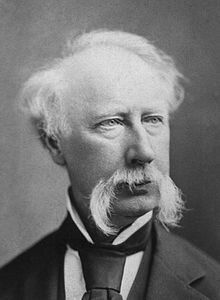Nationality American Occupation surgeon; professor | Name David Agnew Role Surgeon | |
 | ||
Known for The Principles and Practice of Surgery Education University of Pennsylvania Books The principles and practice of surgery | ||
David hayes agnew
David Hayes Agnew (November 24, 1818 – March 22, 1892) was an American surgeon.
Contents
Biography
Agnew was born on November 24, 1818, Nobleville, Pennsylvania, (present-day Christiana). His parents were Robert Agnew and Agnes Noble. Agnew grew up as a Christian. He was surrounded by a family of doctors and had always known he was going to become a physician. “From the time that he was first able to play, he would ride a cane for a horse, and, clad in one of his father’s vests, which reached nearly to his heels, he would stuff his pockets with bottles and powders, and pretend to visit his patients.”—Jeddiah Adams (Author of History of the Life of D. Hayes Agnew). As a young boy, he had a sharp sense of humor and was very intelligent. He graduated from the University of Pennsylvania School of Medicine in 1838. He returned to Nobleville to help his father in his clinic. He worked there for two years. His father was an asthmatic and moved to Maryland in 1840 because the climate was more suited to his condition. Agnew moved with him. On November 21, 1841, he married Margaret Irwin. In 1852, he bought and revived the Philadelphia School of Anatomy. He held responsibility for ten years until 1862. During the American Civil War he was consulting surgeon in the Mower Army Hospital, near Philadelphia, and acquired a considerable reputation for his operations in cases of gunshot wounds.On December 21, 1863, he became the Demonstrator of Anatomy and Assistant Lecturer on Clinical Surgery at The University of Pennsylvania. Later, he was requested to assist the Professor of Surgery in the Conduct of the surgical clinics. In the year 1865, he gave summer instruction courses. For the next seven years, he worked for the University as Demonstrator of Anatomy. A large portion of his success was due to his wife’s energy, intelligence, and determination. She gave him an impetus to try harder and not be satisfied with his first try.
The Garfield Case
On July 2, 1881, President James A. Garfield was shot by Charles J. Guiteau. He held the position of chief consulting surgeon. When a committee came to give him his money for helping, Agnew said, “Gentlemen, I present no bill for my attendance to President Garfield. I gave my services freely and gratuitously”. He was never optimistic about the President’s case and was not fooled by fallacious beliefs. This procedure helped create Agnew’s reputation.
The Agnew Clinic
The Agnew Clinic is a famous painting by Thomas Eakins. It was painted in 1889. In the painting, he is depicted conducting a mastectomy operation before a gallery of students and doctors. Agnew became the subject of the largest painting ever made by the Philadelphia artist Thomas Eakins.
Accomplishments
David Agnew wrote The Principles and Practice of Surgery. It was a 3 volume set that he published from 1878-1883. He also helped found the Irwin & Agnew Iron Foundry in 1846.
Death
Agnew caught a severe attack of epidemic influenza in 1890. He never fully recovered. Following this, he had an attack of broncho-vesicular catarrh. On March 9, 1892, he was put in bed for a series of medical problems. After a few days it started to get better but suddenly on March 12 it became much worse. On March 20, he fell into a comatose condition. Agnew stayed like this until he died at 3:20 p.m. on March 22, 1892. He is now buried in West Laurel Hill Cemetery.
